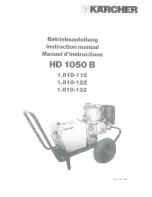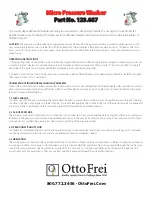
12
3. Remove the cap on the inner side of the lid by pulling it towards you.
4. Remove the silicone sealing insert of the lock valve and remove the valve itself. Rinse all parts of the steam and lock valves.
5. Reassemble the valve in reverse order of disassembly. Place the lock valve back into its original position, put the
sealing insert on it, fit the protective grid of the steam valve to the thrusts until tight. Tightly fix the steam valve to
the slot on the lid of the appliance.
ATTENTION! To avoid deformation of the valve’s rubber, do not twist and pull it after removal, cleaning and mounting.
DO NOT clean the inner lid in the dishwasher.
To Remove Condensate
In this model the condensate accumulates in the special cavity on the housing around the bowl and drains into a special
container, located on the back side of the appliance.
1.
Open the lid, remove the bowl. If necessary slightly lift the front part of the electric pressure cooker, so that condensate
completely drains into the container.
2.
Remove the container, slightly pulling it.
3. Pour the condensate out. Wash the container, following the instructions aforementioned and insert into the place.
4. Wipe off any condensate remaining around the bowl with a dry cloth.
Cleaning the Working Chamber
Compliance with the user manual guidelines minimizes the risk of food particles or liquids accumulating inside the cooking
chamber.
However, if the inside of the chamber gets dirty, clean it to prevent improper operation or malfunction of the unit.
Walls of the cooking chamber, surface of the heating disk, and the casing of central thermal sensor (located in the middle of
the heating disk) can be cleaned with a damp (not wet!) sponge or cloth. Remove any traces of soap or detergent if using
any to prevent unwanted odors during cooking. If there is a foreign object in the cavity around central thermal sensor, care-
fully remove it using tweezers, trying to avoid pressing on the casing of the sensor. Clean heating disk with a damp medium-
hard sponge or synthetic brush, if necessary.
During regular operation of the device, the heating disc may totally or partially change its color. This is not a sign of the device
failure and does not influence on its operation.
Transportation and Storage
Before repeated operation or storage completely dry all parts of the appliance. Store the assembled appliance in a
dry, ventilated place away from heating appliances and direct sunlight. During transportation and storage, do not
expose the device to mechanical stress, that may lead to damage of the device and/or violation of the package integ-
rity.
Keep the device package away from water and other liquids.
VII.
BEFORE CONTACTING THE SERVICE CENTRE
Problem
Possible cause
Solution
Display shows the error code: Е*,
the device gives 6 short audible
signals
System error, possible control board or heating element
malfunction
Unplug the appliance and let cool down.
Close the lid tightly and plug in the ap-
pliance
Appliance does not switch on
Power cord is not connected to the appliance and/or
socket
Ensure that the power cord is connected
to the corresponding inlet on the housing
of the appliance and to the socket
Wall socket is not working properly
Connect to a properly working wall
socket
Power supply failure
Check the power supply. If not available,
contact local electricity supply company
Problem
Possible cause
Solution
Dish is taking too long to cook
Power supply interruption (power supply is unstable/
underrated)
Ensure that the power supply is stable. If
unstable/underrated, contact local elec-
tricity supply company
There is a foreign object between the bowl and the
heating element (grain, food particles, debris, etc.)
Unplug the appliance and let cool down.
Remove foreign object or objects
The bowl is not properly positioned
Properly position the bowl into place
Heating disk is dirty
Unplug the appliance and let cool down.
Clean heating disk
Hot steam escapes from under lid
during cooking. The count of
program running time starts
Inner lid and cooking
bowl fail to seal her-
metically
The bowl is not properly posi-
tioned
Properly position the bowl into place
The lid is not closed properly;
foreign object under lid
Remove foreign objects (grain, food par-
ticles, debris, etc.) from under the rim, if
any. Always close the lid until it clicks
into place
Sealing ring is dirty, deformed,
or damaged in any way
Check the sealing ring. Replace, if neces-
sary
Hot steam escapes from under lid
during cooking. The count of
program running time fails
Sealing ring is lost
Check the sealing ring
When the device operates in the
pressure cooker mode, steam
keeps going out of the hole of
shutoff valve. The count of pro-
gram running time fails
Shutoff valve is dirty
Clean the shutoff valve according to the
Maintenance Section
Shutoff valve or its sealing rubber is lost
Check for shutoff valve and its sealing
rubber
In case you didn’t manage to eliminate the defects, please, refer to the authorized service centre.
Environmentally friendly disposal (WEEE)
The packaging, user manual and the device itself shall be taken to the applicable collection point for the recycling
of electrical and electronic equipment. Do not throw away the electronic waste to help protect the environment.
Old appliances must not be disposed with other household waste but must be collected separately. Municipal
disposal of recyclable wastes is free of charge. The owners of old appliances are required to bring it to a waste
facility centre. With this little extra effort, you can help to ensure that valuable raw materials are recycled and pollutants are
treated as appropriate.
This appliance is labelled in accordance with European Directive 2012/19/EU — concerning used electrical and electronic
appliances (waste electrical and electronic equipment WEEE).
The guideline determines the framework for the return and recycling of used appliances as applicable throughout the EU.
Summary of Contents for RMC-PM381
Page 3: ...3 A1 13 14 15 16 18 4 5 2 1 12 17 3 11 10 9 6 8 7 ...
Page 5: ...5 4 5 1 2 3 6 7 8 A3 ...
Page 13: ......
Page 14: ......


































